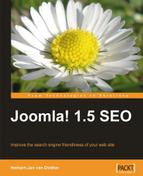It's time to start working on the content, and this should be fun as you will see your site grow with every article that you publish. The first page I want to edit is the 404 page. The 404 error does not say a lot to your visitors; it only indicates that they did not reach the page they expected.
The 404 page is great for guiding people back into your web site. So, change it to something more than just a "404 Page not found" item. Here is what I made of it.
I created a line with a link to the home page and a link to the Sitemap page. I pointed to the menus on top and the side, and used a Search box from Google that will allow visitors to search the site for the information they are interested in. Remember, I said that a topic should always be image rich, and so here you can see an image on the 404 page.
The image is linked to the sitemap. If you use images, be aware of the fact that your visitors will be clicking on those images irrespective of whether they are linked. You can use this to your advantage by linking your images it to a relevant article or category on your site whenever possible.

Whether you use the SEF patch or not, please set the Robots meta tag option to noindex, follow.
By using noindex you make sure the 404 page doesn't show up in the search engine indexes, but your links still count and you don't want Google to think that you don't trust your own site, so set the follow tag.
When you start writing the site's content, use the fields introduced by the SEF patch to your advantage. If you don't, why did you install it? So, let's see how I have used it on a page with the title Japanese Gardens.

It is a very generic title and also very short. The title looks fine on the page, but it is too short to get good rankings. So, using the extra HTML Title field you can give the page a better title that will show in Google's search result pages.
For this page I chose How to Design your Japanese Garden, which should attract some more hits and also give extra keywords such as "Design" and "How to". On the page add a short description for the meta tag by the same name and use some keywords that are also in the content of the page.

As you can see in one of the previous screenshots, there is a You Tube video embedded with a green border. You can find the color options, under the embed function for the video on www.youtube.com.

Writing and creating content can be done very quickly and, depending on the time you want to spend on your web site, your site can grow very fast. If you don't have that much time, make sure the number of pages grows to at least 10 or more. If you can rank with just five pages, you are in a niche without much competition.
Growing quickly gives you the possibility to rank with more pages in a short period of time, but it can be seen as a spam indicator also. You could get sandboxed by Google and it will take longer for your site to get the rankings it deserves.
Growing steadily means taking time to build the site piece by piece, by adding two or three pages per week, which will show very good results in the end. If you are looking for growth, you need to keep in mind that there should be enough content to encourage your visitors to come back to your site.
